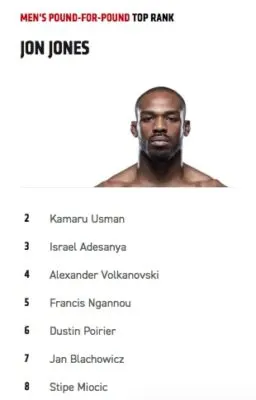UFC is the leading MMA promotion and home to over 600 skilled fighters. To make it easier for the fans to navigate through each weight class and find out who are the best fighters, the UFC uses the famous “ranking system”. This is a system MMA took from boxing and the way it works is very simple.

The UFC rankings system is very straightforward. More than 20 media members from various MMA networks vote on the rankings. Their job each week is to vote on the top 15 fighters in each weight class. The UFC then uses their votes to determine fighters’ position in the rankings.
Keep reading this article as we will go into more details about how UFC rankings work.
How are Rankings Determined in the UFC?
The way UFC rankings work is very simple. The rankings are voted on by more than 20 media members from various MMA networks. Each week, their job is to vote who are the top 15 fighters in each weight class. They also vote on pound-for-pound rankings to find out who the best fighters are regardless of the weight class. The UFC then collects all the votes and uses the final results to make the changes in the rankings.
There are no strict criteria on how the members of the voting panel should vote. The rankings are entirely based on their opinion only, but at the same time, they must stay neutral. In most cases, they use current as well as past fighter results to decide fighters’ position in the rankings.
They use data and stats such as wins and losses. Most of them focus on recent fights and results as well as the reputation and legacy of the fighter. Some other factors that play a big role in their votes are the method of victory and the quality of opponents.
It’s important to point up that they do not vote for interim and undisputed champions. This is because the champ is clearly the best in the weight class while the interim champ is the second best.
If you are curious about what is an interim champion, I wrote an article all about “why does UFC have interim champions” that I strongly encourage you to read.
How often are UFC rankings updated?
The UFC rankings are updated every week. The panel consisting of media members must vote and update the rankings within 48 hours of the last UFC event. Even when there are no UFC events on Saturday, they still need to give their votes which are, in that case, just a formality. Here is one example on how UFC updates the rankings.
For instance, let’s suppose a #8 ranked fighter competes against the #5 fighter on Saturday. If he/she wins the fight, the media members would, in that case, vote for that fighter to climb the rankings and enter the top 5. By Tuesday, the UFC would make the changes by moving the #8 ranked fighter up inside the top 5, while the losing fighter would drop down few places. This is a short explanation of how the UFC updates its rankings.
Who votes on UFC rankings?
People who vote on UFC rankings are the media members, in most cases journalists, who work within the MMA industry. Back in 2013 when the rankings started, there had been around 100 journalists. In modern days, this number has dropped down to between 20 and 30 people.
These journalists and networks they work for are not based in the US only. No, the votes on UFC rankings come from all parts of the world like the US, Brazil, Russia, or Australia. However, the names of the people who vote on the ranking are not disclosed to the public.
In the past, the UFC used to publish the names of all the members of the voting panel on their website. People were able to see who these people were and their backgrounds to better understand what made them qualified to decide which fighters were the best in the world. We could also see the details on how each panelist voted. But this is no longer the case since the UFC has decided not to disclose who votes on the UFC ranking.
As a result, we don’t know the names of all people who vote on the UFC rankings. But, here are a couple of past and present names (source):
- Rodney James Edgar (former MMA fighter and journalist)
- Eric Kowal (MyMMAnews)
- Shawn Dallas Hall (MMA Fight Coverage)
- Scott Lewis (Inside Fighting Radio)
- Ashah Tafari (MMA NYTT)
Who are the media networks that decide the UFC rankings?
All media members who have the right to vote work for the major MMA or Sports networks. These networks come from all around the world like Brazil, Russia, Sweden, and, of course, the US. Most of these networks focus on MMA only and here is a shortlist of the most popular ones:
- FighteNews
- Gazeta Esportiva
- Inside Fighting Radio
- Portal do Vale-Tudo
- Burbank Leader
- ESPN.com
- MMA Weekly
- NY Post
- Canal Combate
- Fight Network
How many ranks are there in UFC?
The UFC rankings cover all the weight classes. Each weight division includes the ranking list of the best 15 fighters and there is also a pound for pound ranking list that takes the weight out of the equation and ranks the best fighters from all divisions. Since there are 12 UFC weight classes for both men and women, this means that we have 13 ranks, including the pound for pound list as well.
What Does Pound for Pound mean in the UFC?
Pound for pound, or P4P, is a ranking list that consists of only the best fighters from all weight classes. This term comes from boxing and one of the first fighters to receive this “title” was Sugar Ray Robinson. At the time, people called him a pound-for-pound king which meant “the best boxer in the world regardless of the weight class”. In modern days, pound-for-pound has become a part of the official ranking system in various sports like boxing, MMA, and wrestling.
The first media network to come up with the “pound for pound” ranking list was “The Ring” magazine in 1990. When it comes to MMA, the UFC created the pound-for-pound ranking list in 2013. It’s important to point out that there are also a couple of unofficial ranking lists by various MMA media such as ESPN, Sherdog, and Tapology.
Why is pound-for-pound important in the UFC?
A pound-for-pound ranking list is very important in the UFC because it shows us the best fighters regardless of the weight class. In some way, you can look at the #1 ranked pound-for-pound fighter as the “Ultimate Fighter”. He/she is, in most cases, the most skilled fighter who has faced and beat every opponent from their weight class or era. These are the finest athletes in the world and are often seen as the greatest as well.
In theory and on the fundamental level, a pound-for-pound best fighter has the skills to face and beat fighters from all weight classes. But we will never see this in the UFC, and these debates will forever remain without an answer. The UFC will never match a 205 lbs fighter against the best from the 125lbs weight class simply because the state athletic commission will not approve the fight.
Instead, modern MMA fighters and boxers focus on “beating” each other on the pound-for-pound ranking list by accomplishments and records.
How are UFC pound-for-pound rankings determined?
The process of ranking the best pound-for-pound fighters is the same as for weight classes. There are around 20 to 30 selected journalists from various MMA media networks who vote on the pound-for-pound rankings on a weekly basis. But the only difference is that this list ranks the best fighters from all weight classes.

The pound for pound list consists of, in most cases, champions of each UFC weight class, and other best fighters. To find out which one is the best, the members of the panel would look for the most dominant fighters who have been on the longest winning streaks or have most title defenses for instance. They will also look at their legacy, the quality of the opponents they faced, and other factors such as how active they have been in their careers.
Who are the best pound-for-pound ranked UFC fighters of all time?
Since the introduction of the UFC rankings in 2013, there have been many great fighters who entered the pound-for-pound ranks. But some of the greatest fighters who held the #1 spot or have been inside the top 5 were:
- Demetrious Johnson — is the most dominant UFC flyweight champion in history with 11 title defenses. At one point in his UFC career, he was on a 13 fight winning streak, out of which 12 wins were in title bouts.
- Jon Jones — is often seen as the pound for pound the best of all time. He became the youngest UFC champ by winning the title at the age of 23. He went on to beat every fighter from his weight class and era, and a couple of fighters from the new generation as well.
- Anderson Silva — is the most dominant 185 lbs fighter of all time and the former UFC champ. In his career, he defended his crown 10 times and holds a record for the longest title reign in history (2457 days).
- Jose Aldo — at one point, Aldo was among the best P4P fighters. He is the former WEC and UFC 145 lbs champion who had defended his title seven times in his career.
What are the main problems with UFC rankings?
Although UFC rankings are a very helpful tool and good for the sport, the concept is far from ideal. In fact, there are many issues with the ranking system and we hope the UFC will address them in the future. Here is all you need to know about some of the biggest problems with how the ranking system works.
The lack of voting criteria
Don’t get us wrong here, it’s great that the voters have full freedom to express their opinions. But at the same time, this causes a lot of confusion when it comes to certain scenarios.
For instance, one of the biggest problems is the inactive fighters. In recent years, we can see a lot of high-level fighters taking long breaks. And journalists who vote on the rankings are the ones who are advocating for a change because inactivity has a big impact on the way they vote. There are no criteria on how they should deal with these fighters and their place in the rankings:
“I’ve handled these situations before in the past and thought to myself, ‘Should I take it upon myself?’ For instance, when Nate Diaz went that long time between fights, he was still available to be ranked for a long time before he was finally pulled and it was very difficult knowing should I keep him in or not?”
David Brown of the Cherokee Scout, source
Biased voting
The members of the voting panel are also the fans of the sport and they have their favorite fighters and the ones they don’t like. If you combine favoritism with the lack of voting criteria, you have a perfect recipe for biased voting. And this has happened a couple of times in the past.
The best example of this came shortly after the UFC 194. This memorable event saw Conor McGregor knocking out Jose Aldo in just 13 seconds. After the event, most journalists voted to move the Irishman up in the pound-for-pound ranking list, which was the only right decision. But the panelist from Brazil, Marcelo Russio, actually moved McGregor down the rankings, which was completely out of line.
Lack of transparency and credibility
The biggest issue with the UFC ranking system is the lack of transparency. We don’t know who all the panelists are, and how qualified they are. Some of the known panelists are very credible like Brett Okamoto and Mice Raimondi. But in reality, most panelists are unknown, and fans do not know anything about their backgrounds.
Related Questions
How is ranking determined in Bellator MMA?
Bellator introduced its official ranking system in March 2021. The rankings are voted by the panel of media members from various MMA networks, very much the same as in the UFC. Bellator asks the media members to vote for the 10 best fighters in each division, and pound for pound as well. They must submit their votes due to Monday following each Bellator event. The votes are handled by “Combat Registry”, which is a third-party independent of Bellator.
Some of the inaugural media members are:
- Brian Campbell — CBS Sports
- George Garcia- MMA Junkie
- Ken Pishna — MMA Weekly
Bellator rankings differ a lot from the UFC rankings since Bellator has voting criteria. The media members have the full freedom to give their opinions on which fighters are the best in each division and pound for pound. But, there are some rules when it comes to:
- Inactive and retired fighters and the ones under medical suspension
- Fighters who compete in multiple weight classes
These rules do not have an impact on their final decision on who are the best fighters. It’s more of a guideline on how they should deal with inactive fighters who are holding up the rankings.
